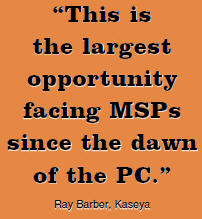BYOD: The No. 1 Missed Managed Services Opportunity
By Jay McCall, Business Solutions magazine
Understanding the impact the BYOD (bring your own device) trend has on your customers can lead to stickier customer relationships and higher profit margins for your business.

We’ve talked a lot about managed services in this year’s Business Solutions tech trends. In our April issue, I focused on the large segment of the channel population that hasn’t yet started selling managed services (see “Overcome Your Aversion to Selling Managed Services”). In our February issue, we focused on selling managed print services (see “Expand Your Business With Managed Print Services”), and in our January issue, I touched upon “7 Steps For MSPs To Achieve Recurring Revenue.” This time, I thought it would be appropriate to get some expert advice on the following question: “What are the top missed opportunities among MSPs?” Industry experts from RMM (remote monitoring and management) vendors Kaseya and N-able, and an industry expert from PSA (professional services automation) vendor Tigerpaw provided compelling feedback on this topic.
Mobile Device Discussions Pave The Way For Other Managed Services Opportunities
I received various answers to the question about the top missed opportunities among MSPs, but one common response among them all was related to a trend that’s become known as BYOD. This trend is also referred to as the “consumerization of IT,” which is a reference to employees bringing their own (consumer-grade) devices to work and using those devices for work-related purposes, also. How big of a deal is this? According to the latest stats from Infonetics Research, the mobile segment of the security client market jumped 76% in 2011 and is forecast to grow at a compound annual growth rate (CAGR) of 35% through 2016, growing five times as fast as the desktop computing segment. Even more compelling: Gartner predicts that by 2014, 90% of organizations will support corporate applications on devices owned by workers.
In the past, end users often went to extremes about employees wanting to access the company network via their smartphones — either denying the request altogether or permitting carte blanche access without much thought of any repercussions. If Gartner’s predictions are right, it looks like those businesses that once took a hard stand against allowing consumer devices onto their networks are changing their positions. And, this is good news for MSPs. “This is the largest opportunity facing MSPs since the dawn of the PC,” says Ray Barber, senior product marketing manager at Kaseya. “The opportunity immediately doubles or triples the size of market of manageable devices for those MSPs that have a ‘per device’ charging model, and for MSPs with an all-you-can-eat style service, it creates a stickier relationship with their customers.”
One of the primary reasons your customers need your services to manage employee devices is to help them secure their networks as well as their employees’ devices, which are now carrying around sensitive company information. In addition to authentication security, a service such as remote wipe is important for instances when employees lose their mobile devices, to ensure sensitive data doesn’t get in the wrong hands. Service needs don’t stop with security, however. “When talking to your customers about mobile devices, there are opportunities to engage the customer in discussions about media delivery and storage,” says Patrick Kielion, training and education specialist at Tigerpaw. “These complementary areas help open the door to additional conversations with the customer on how to best customize and address their individual needs. Some MSPs are going even further by conducting wireless usage audits to help their midsize and enterprise customers better manage their wireless plans.”
 Where Do You Begin Selling Mobile Management Services?
Where Do You Begin Selling Mobile Management Services?
Like adding any new service to your business, the toughest part is usually figuring out where to start. N-able’s Frank Colletti, director of sales, offers some words of wisdom. “So often, MSPs go knocking on doors with a generic managed services message, and it creates more objections than sales.” Colletti advises MSPs to segment their customers into three categories: 1. Those already on a fully managed services plan, 2. Those customers being serviced in an ad hoc manner, and 3. Prospects. The next step, according to Kaseya’s Barber is to create a clear message defining what your mobile service is and being clear about features and benefits of this service. Your existing clients who are already on a managed services plan should be the easiest ones to add the new offering to. “MSPs also can use their mobile device management messaging to turn ad-hoc clients [i.e. those on break/fix plans] into managed services customers, too,” he says. “Your success depends partly on educating your clients about the business impact of lost or compromised mobile devices. It also depends on your ability to reinforce the ongoing peace of mind that is the mainstay of all managed services offerings.”
One other area MSPs should pay attention to with regard to selling mobile device management services is gaining knowledge about the various device form factors and mobile operating systems. This is important not just so you can ensure you’re truly able to manage the myriad of devices your customers could potentially ask you to manage, but also so you can have informed conversations with your customers about the devices and operating systems that best suit their needs.
